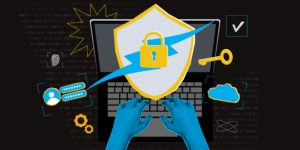The week before Hurricane Ike came traipsing through our city and took out our power here at CurrentMarketing, I was in a quandary. I deal with a lot of data, in the form of video and audio files mostly, and I have resisted buying a RAID storage system as being too expensive and complicated for my needs. When we first started editing video, all of our footage was delivered via tape. If I ever lost my digitized video due to hardware failure, I would just recapture from the physical media and order would be restored. About four years ago, however, we began shooting everything in HD, and the majority of our footage came to us via hard drives. Since we work primarily with compressed HD (DVC-Pro HD 720p), we can store our footage on external drives and work with the files over the firewire bus. So the more cost-effective solution was to purchase external drives and use them as if they were physical tape.
The only problem with that solution is that hard drives fail. So the digital assets need to be stored on at least two different drives, one of which should be in semi-active use. Eventually, I acquired an array of desktop hard drives that increased my storage capacity to more than 4 Tb, but became increasingly unwieldy to manage. Which footage was on which drive? At first, there was a plan, and certainly good intentions, but with a heavy workload, quick decisions had to be made and organization went out the window.
A few weeks I received an email touting a device called the Drobo, an appliance that was essentially a RAID storage system that needed no management, which appealed to me, because my head is so full already, I didn’t want to learn about RAID management. What the Drobo does is give me a storage device with multiple drives that automatically backs up my data. If I need more storage, I just purchase larger drives and put them in the Drobo, and voila! No more worries.
So we purchased a 4 Tb Drobo, and I began to fill it with all my digital-only assets. Two days later the power went out. Fortunately, I had no pressing deadlines at the time, so I decided to wait until the power came back on. I got to take the kids to the zoo, I got to spend time with my wife, I occasionally had to come down to the office and help make plans for accommodating the workflow. But as the days dragged on, it became more apparent that I would eventually have to find a way to power up the computer and get some stuff done. Almost everything I do is digital. Without a computer, I’m idle, and I had projects that were beginning to nag for my attention.
I carefully weighed my options. I could run my rig off of a generator, but that would eat gas, be environmentally unfriendly and would act like a countdown clock – gotta finish before the gas runs out! I could harness the energy of all these kids and dogs that tend to lope around here, put them all on a big hamster wheel, hook that up to a turbine that turns a generator… but that’s too much effort to set up. At last, facing deadlines, I hauled my CPU, extra-big monitor and almost all of my hard drives home. It took me about 2 hours to break down, pack up, transport and set up in the bowels of my house, but by dinnertime, I was ready.
36 hours later the power came on. I had only got one solid day of work done in my basement, and I came down to make sure the power was on in my office before hauling everything back down to Bakery Square. By 11am, I was back in business and ready to check my Facebook page again.
So lessons learned: electricity is a good thing; it’s worth the time and money to buy a storage solution that is compact and self-saving; and when the infrastructure collapses, I may still be able to make a living lifting heavy things.

Data Privacy vs. Personalization – Finding the Balance
Consumers want personalized experiences, but they also want their privacy. As marketers, that puts us in an interesting spot. For years, we’ve relied on data



